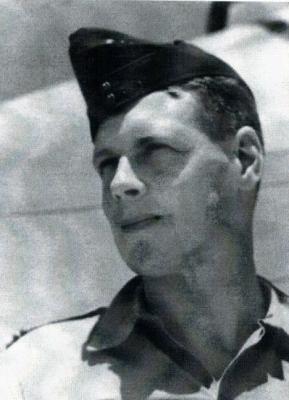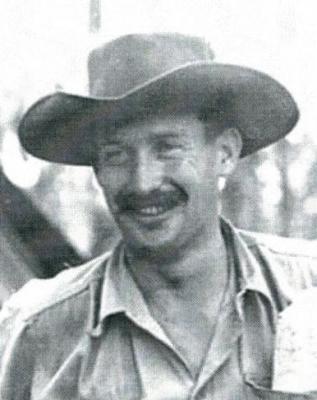By John Telfer
Local military history writer and researcher JOHN TELFER shares his first contribution for 2021 – the Warwick connection to the famous ‘75th Squadron’…
Throughout Warwick’s World War 2 history, many genuine heroes have emerged from World War 1 to Afghanistan but there is one unique story that should be told. It is about the three local men who have all Commanded the RAAF’s 75 Squadron. All were involved in the Battle of Milne Bay in 1942 that turned the Japanese back in their advance towards Australia, and all have a link to the City of Warwick. Between 1942 and 1945, the three men included Squadron Leader John Jackson, his younger brother Wing Commander Les Jackson and, the more famous Group Captain Wilf Arthur. As well, two other Warwick men were associated with 75 Squadron in 1942, they were the Squadron medical officer, James Deane-Butcher and the Squadron Warrant Officer Disciplinary, Edgar McCulloch. They are another story, but the three Commanding Officers are what this story is all about.
John Francis Jackson was born on 23rd of April 1908, one of three sons to William and Edith Jackson of Clayfield, Brisbane. He received his early education at Brisbane Grammar School before moving to The Scots College Warwick, to complete his senior education before moving to St. George, Queensland, where he became a highly successful Stock and Station agent. This occupation required plenty of travel to outback areas, so John decided that the best method to travel was to fly so he learnt to fly. He became fairly proficient in his Beechworth 5 seater- plane, completely unaware that in a few years, he would be flying into battle against Japan.
In 1938, John joined the Citizens Air Force, and later the Royal Australian Air Force where he was posted to No3 Squadron in the Middle East. He flew Gladiator and then Hurricane aircraft, against Italian and German air forces. He also flew combat missions in Libya, Syria and Cyprus, and quickly developed a reputation as a fighter “ace” winning the Distinguished Flying Cross and a Mentioned in Despatches. In March 1942, John was promoted to Squadron Leader and posted to New Guinea to Command the newly formed 75 Squadron and to fly the RAAF’s newly acquired Kittyhawk aircraft. However, after 44 days of constant combat where John distinguished himself as one of the RAAF’s top pilots alongside such luminaries as Clive “Killer” Caldwell and “Bluey” Truscott, he was shot down but survived his parachute descent into mangroves and, later, found his way back to his squadron with the help from New Guinea’s “Fuzzy Wuzzy” angels. But on the 12th April 1942, John Francis Jackson made the supreme sacrifice when he was shot down and killed by enemy ground fire.
In a stroke of irony, John Jackson’s brother Les, who had joined the RAAF as aircrew was also a member of the squadron in 1942. He took over command and also distinguished himself just like his older brother John. Les was also born in Brisbane on 24th February 1917, and educated at Brisbane Grammar School. On leaving school, Les worked in the family business of J. Jackson & Co. Pty Ltd, before buying a garage and service station at Surat, in Queensland. He, like his older brother John, also joined the Citizen’s Air Force before enlisting in the RAAF on 6th November 1939, and was commissioned as a Pilot Officer in February 1940. He served in Darwin, Singapore and Brisbane, before being posted to 75 Squadron under the command of his brother John, to take part in the Battle of Milne Bay. In the battle, Les shot down 4 enemy Zeros and damaged 2 Japanese bombers. For this action, Les, like his late brother John, also was awarded the Distinguished Flying Cross, as well as a Bar to that award. In this battle, both 75 and 76 Squadrons and their Kittyhawk fighter planes, played a decisive part in the victory.
Les was posted back to Australia in 1943 on staff duties, but in November 1944 he was appointed as Commanding Officer of the RAAF’s 78 wing and promoted to Wing Commander. Les went into further air battles over New Guinea, New Britain and the Netherlands, before his demobilisation on 8th February 1946. After the war he ran Active Motors at Roma, before purchasing Western Queensland Motors in St. George in Queensland. Les passed away on 17th February 1980 at Southport.
The third member to have commanded the famous 75 Squadron in New Guinea was the legendary Wilfred “Woof” Arthur, who became one of the top air aces of World War 2. (Space does not allow for a full outline of Wilf Arthur’s career but it is outlined in my book “Profiles of Courage” available at Scots College). However, briefly, Wilf was born at Yelarbon on 7th December 1919, and received his early education at Yelarbon State School before entering Scots College at Warwick, where he had an outstanding four years there as a boarder. He became a Prefect in his second year and was appointed College Captain from 1936 to 1938, until he enlisted in the RAAF as a trainee aircrew almost straight from school.
After initial training, Wilf was posted to No 3 Squadron in the Middle East and after landing at Bombay the squadron was sent to Suez. Wilf was into combat on 12th December 1940, when he flew against an Italian fighter plane and recorded his first “kill” in his Gladiator aircraft. He quickly made a name for himself in the Middle East as he continued to chalk up 8 enemy aircraft destroyed despite being shot down twice himself. In November 1941, Wilf became engaged in a “dog fight” with German and Italian aircraft before he was forced to bail out. In one engagement he was forced to crash-land his Tomahawk aircraft within sight of the Tobruk fortress. He escaped to the fort then borrowed another aircraft to get back to his squadron. For this action he was awarded the Distinguished Flying Cross on 20th January 1942.
Wilf was promoted to Squadron Leader and posted to No 76 Squadron, at Port Moresby, and after the death of John Jackson, took over 75 Squadron. On 15th April 1943, Wilf displayed the courage that he was noted for when he led the squadron against an estimated 100 Japanese zero fighters, and despite have his guns jammed, he never turned back using his flying skill to evade the Japanese zeros and for this heroic action he was awarded the Distinguished Service Order (DSO) Wilf went on to attain the rank of Group Captain, survived the war and came home to give further service to his country, but because of time and length of this short story readers will have to read the book mentioned previously.
The main point of this story is that apart from the Clowes brothers of Warwick who created their own fame, it is rather unique that all these men had walked the streets of Warwick, before going on to greater things in later life, and perhaps some sort of record that three Warwick men commanded a famous RAAF squadron in World War 2.








